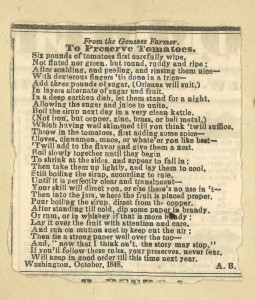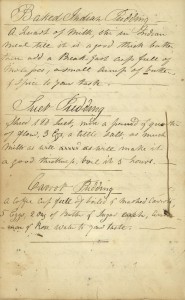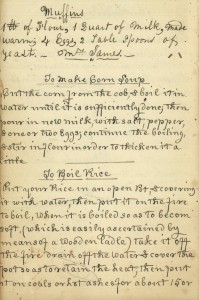A surprising find in my box of Steward family papers is a combination cookbook–book of home remedies. It is a surprise not as a document – the R. Stanton Avery Special Collections at NEHGS holds many such hybrids – but as a lone example of something from my paternal grandmother’s family in a collection of Steward, White, and Beeckman papers.
To be specific, the cookbook section’s front end paper reads The Misses Beekman. My grandmother was named for her maternal great-great-grandmother, Anne Beekman (1784–1842), who married John Finlay of Montreal in 1809, and the Misses Beekman were Mrs. Finlay’s unmarried sisters, Aletta Beekman (1787–1851) and Cornelia Beekman (1790–1826).[1]
When the handwriting changes, another recipe is attributed to “Mrs. James”: Anne, Aletta, and Cornelia’s older sister, Sarah Beekman (1782–1857), who was married to Richard James 1810–23. I will hazard a guess at the second compiler: my great-great-great-grandmother, Elizabeth Lawrance Fowler (1824–1865), wife of John Beekman Finlay 1842–65, who would have addressed her husband’s aunt, at least as a young bride, as “Mrs. James.” Her handwriting, by the way, is eminently legible with its spiky flow.
Turning the volume over, one finds New-York November 15th 1819/Broadway on the end paper; on the facing page there are obscure references to dates in 1823 and 1825, all during the lifetime of Cornelia Beekman. The remedies range from “Syrup for Coughs and Spitting of Blood” to “Cure for Worms”; the book includes an “Antidote against Poison”:
A Decent spoonful of made mustard, mixed in a Tumbler of Warm Water, and drank immediately it acts as an instantaneous Emetic.
Elizabeth Lawrance Finlay, if hers is the second hand, is partial to recipes for “Eau de Cologne” and “Tincture of Roses”:
Take the leaves of the common rose plant[;] place them, without pressing them, in a bottle[.] [Pour] some good spirits of wine upon them, close the bottle, & let it stand until it is required for use. This tincture will keep for years, & yield a perfume little inferior to [attar] of roses; a few drops of it will impregnate the atmosphere of a room with a delicious odour. [Common] vinegar is greatly improved by a very small quantity being added to it.
Continued here.
Note
 [1] Pasted into the cookbook facing the first recipes, for pea soup and calves’ head stew, is a clipping on preserving tomatoes from the Genesee Farmer of 1848, signed with the initials A.B.
[1] Pasted into the cookbook facing the first recipes, for pea soup and calves’ head stew, is a clipping on preserving tomatoes from the Genesee Farmer of 1848, signed with the initials A.B.
Share this:
About Scott C. Steward
Scott C. Steward has been NEHGS’ Editor-in-Chief since 2013. He is the author, co-author, or editor of genealogies of the Ayer, Le Roy, Lowell, Saltonstall, Thorndike, and Winthrop families. His articles have appeared in The New England Historical and Genealogical Register, NEXUS, New England Ancestors, American Ancestors, and The Pennsylvania Genealogical Magazine, and he has written book reviews for the Register, The New York Genealogical and Biographical Record, and the National Genealogical Society Quarterly.View all posts by Scott C. Steward →

